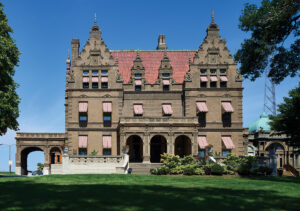14 Towns, 12 Historic Sites and 7 Museums to Visit on the Erie Canal
The Erie Canal’s time has come again. Dubbed the Eighth Wonder of the World when it was completed in 1825, the canal reshaped our young nation, cutting the cost of shipping from western New York and the Midwest to the east by 90 percent. In 2006, a government-private partnership began rehabilitating the long-neglected trade conduit as the Erie Canal National Heritage Corridor. Now it draws about 4 million annual visitors who sail the waterways on rented canal boats or their own craft, or set out on foot or bicycle to explore various sections of the restored towpaths.
Cycling the Corridor last summer, I found each section had a distinct character with evocative sites: rehabbed and untouched canal infrastructure, historic landmarks, once-prosperous towns seeking comebacks, local museums crammed with unusual lore.
Originally 40 feet wide and four feet deep, the Erie Canal took eight years to dig and had 85 locks, rising 500 feet as it covered 363 miles from the Hudson River to Buffalo, N.Y. At Lockport, 15 miles east of Niagara Falls, I saw the most daunting challenge that confronted canal engineers: the 70-foot-high Niagara Escarpment. One of the two original sets of five locks carved from solid rock remain, alongside a pair of modern locks. The nearby Erie Canal Museum www.lockport locks.com/hercent.html offers interactive stations with first-person tales from canal workers—a surprising number were women—as well as famous travelers’ anecdotes, detailed timelines, old-time canal songs and kid-oriented exhibits.
The canal spawned new towns built from materials close at hand. I rode the unshaded gravel towpath 16 miles from Lockport to Medina, whose town center is gorgeous reddish-brown sandstone replete with carved facades. A few blocks away, the canal crosses over Culvert Road—a surreal treat listed in Ripley’s Believe It or Not. On Ridge Road in Albion 10 miles east, I admired magnificent cobblestone buildings created from stones cleared from farm fields; the 1858 Greek Revival courthouse fronts a shady square and historic district. Nineteen miles east of Albion, the Spencerport Depot and Canal Museum www.spencerport depot.com anchors a lovely towpath stretch lined with shady trees and original bridges and locks. The museum, in a converted trolley depot, sits at the center of a gemlike hamlet with well-kept 19th-century frame houses and stone churches.
Some canal towns have invested even more heavily in promoting the waterway’s use. Sixteen miles east, Pittsford Landing at Schoen Place buzzes with restaurants and shops in repurposed structures. I cycled along the “Great Embankment”—a dramatic 70-foot-high skyway level with treetops above the valley floor—into Fairport, where a $1 million rehab has yielded spiffy, service-filled canal frontage. Palmyra, center of 1820s religious revivalism so fierce the area was known as the “Burned Over District,” is nine miles east. Mormon prophet Joseph Smith was born here, memorialized by his house and the Historic Palmyra Museum. The Phelps General Store Museum www.historicpalmyrany.com/ phelpsintro.htm reincarnates how Americans shopped before malls and superstores. At the town’s edge, I rode over the Aldrich Change Bridge, which let horses and mules cross the canal without being unhitched from their barges.
Ideas have always traveled with trade, and the Erie Canal disseminated new unsettling beliefs. The Burned Over District’s fervor fired movements for social reform like abolitionism. Twenty-five miles southeast of Palmyra, Seneca Falls hosted the 1848 convention of abolitionist women who launched the suffragist movement, honored in the National Women’s Hall of Fame www.greatwomen.org. The Cayuga-Seneca Canal, an Erie offshoot, winds through downtown and the unfinished Women’s Rights National Historical Park www.nps.gov/wori. From DeWitt, 32 miles east of Seneca Falls, Old Erie Canal State Historic Park www.eriecanal.org/OECSHP.html runs 36 miles to Rome—a National Recreational Trail and canoe- and kayak-friendly stretch. At Chittenango, 11 miles east of DeWitt, a 19th-century repair barn is the renovated home of the Landing Canal Boat Museum www.clcbm.org, where I learned how these craft—some 100 feet long—were built and maintained. L. Frank Baum, Wizard of Oz author, was born in Chittenango; the sidewalks are yellow brick.
When I cycled the rustic gravel-and-dirt trail to tiny Canastota, seven miles east, I came across an unexpected jewel. The Canal Town Museum www.canastota-canal.com packs two floors with surprising data gathered by dedicated town volunteers. Historical maps, photos, diaries, letters and artifacts invoke the textures of daily life before, during and after the canal’s heyday. The town’s economy was diverse. It manufactured still and movie cameras (the Biograph, an early form of movie projector, was invented here), electric drills, furniture, cut glass, knives, even innovative packaging. Varied crops were farmed: the “mucklands” (humus-rich soil from drained swamps) drew onion-growing Italian immigrants. I grew so absorbed in the past here I lost track of time.
The Corridor offers plenty more: the restored 1842 Nine Mile Creek Aqueduct in Camillus Park; the kid-friendly Erie Canal Village outside Rome; Revolutionary War sites like Fort Stanwix; Eliphalet Remington’s 1828 rifle factory in Ilion; one of the world’s highest lock lifts at Little Falls.
But as Bilbo Baggins sang, “The road goes ever on and on.” To plan your trip, start with www.eriecanalway.org, www.canals.ny.gov and www.ptny.org.
Originally published in the June 2013 issue of American History. To subscribe, click here.




